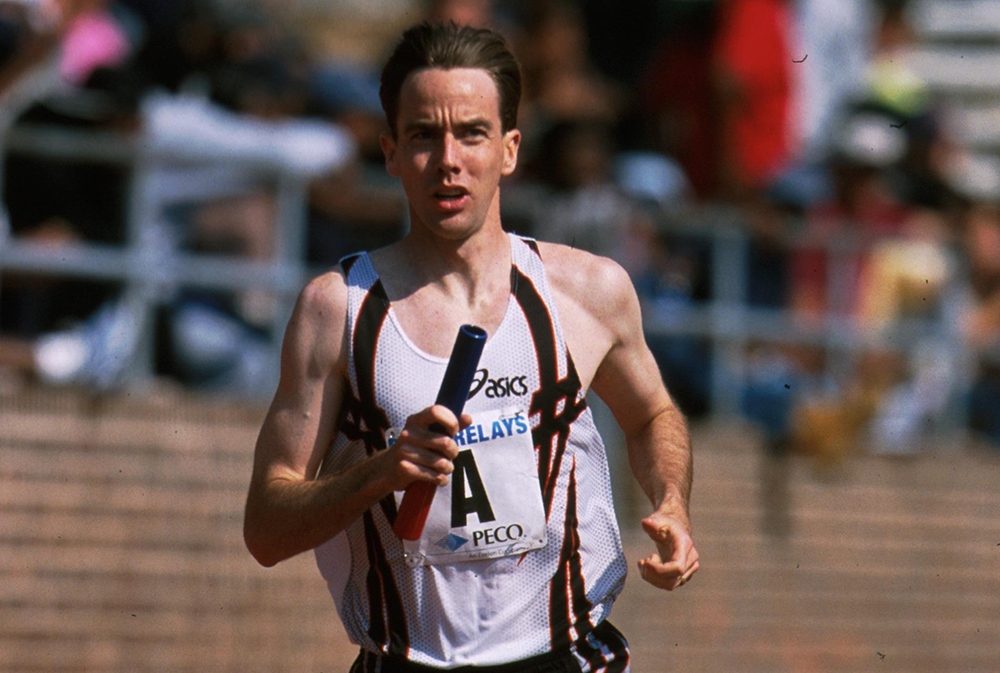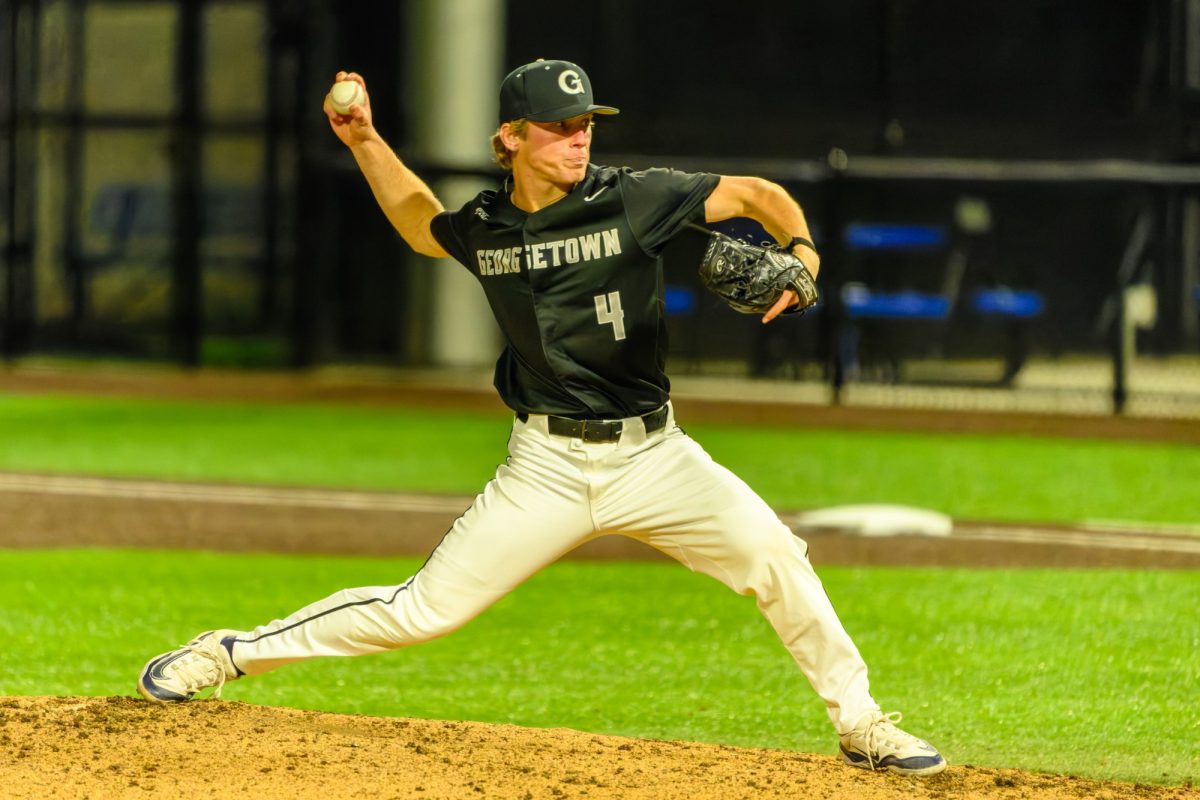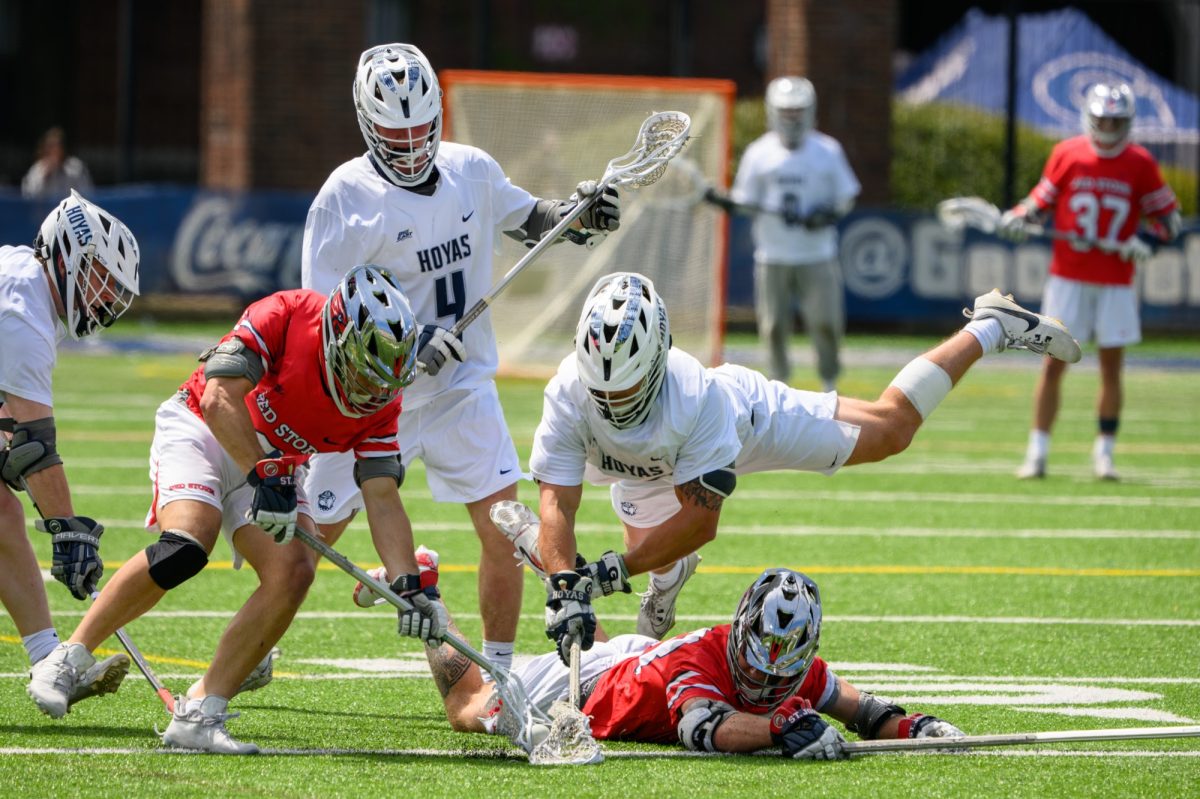When Rich Kenah (GSB ’92) ran track and field for Georgetown University, the team still practiced on a track on top of Yates Field House. In spite of having such oddly placed facilities, the Hoyas’ track program has managed to become one of Georgetown’s most decorated to date, and Kenah participated in that culture of excellence coming to fruition. Throughout his career at Georgetown, Kenah became a middle-distance competitor under Head Coach Frank Gagliano, the famed collegiate track coach. In his senior year, Kenah claimed an individual national championship in the indoor 800-meter race with a time of 1:47.40, his personal best in college.
After graduating in 1992 with a degree in international marketing, Kenah set his sights on the Olympics, continuing to train under Gagliano while he prepared for the 800-meter race in hopes of having the opportunity to represent the United States. Though he narrowly missed the 1996 games, Kenah qualified in 2000 and competed in Sydney, where he placed sixth in his heat.
Today, Kenah is the executive director of the Atlanta Track Club, which boasts the second-highest membership of any running organization in the nation with 34,000 members. The Atlanta Track Club is responsible for organizing the Peachtree Road Race, a 10K race that takes place annually on the Fourth of July. With 60,000 participants running and walking 6.2 miles from Lenox Square Mall to Piedmont Park, the Peachtree Road Race is the largest 10K race in the world. The Hoya spoke with Kenah to talk about his Georgetown career, the Olympics and his role at the Atlanta Track Club.
Why did you choose to attend Georgetown?
I went to high school in New Jersey, and as a high school student-athlete, I wanted to get the best combination of academics and athletics, and Georgetown was clearly that. I had narrowed it down to five different schools, and thankfully I made the right choice.
Georgetown track and field has experienced historic success over the last several decades. What does Georgetown track need to continue to do to remain a perennial contender in the NCAA?
Georgetown continues to attract the best student-athletes from around the country and even from around the world in track and field and cross country. To stay at the highest level, the university just needs to continue to fund the sport, so that today student-athletes have the same opportunities that those in my era had in terms of the ability to travel around and compete against the best of the best in competitions around the country.
What was it like going from being a Georgetown student to an Olympian? What did your path look like right out of college to continue into professional running?
I had a dream of representing the United States at the Olympic Games. So, I committed to my coach, who was the Georgetown coach, post-collegiately as well, that I would take four years to chase that dream. So, from 1992 to 1996, I stayed at Georgetown, trained as a post-collegiate athlete, and I worked a handful of part-time jobs to build a parallel career path for when I finished as an active athlete. … And when we got to 1996, I missed the Olympic team by one spot. At that point, I decided to recommit to an additional four years. During those four years, I developed into a world championship bronze medalist, and then, in parallel, began working with David Falk, who at the time represented the best NBA athletes, including Patrick Ewing and Michael Jordan and Allen Iverson. When I ultimately retired in 2001, I was able to step into a sports marketing career, having had real-world experience.
Tell me about your experience at the 2000 Olympic Games in Sydney.
There’s few things in life that ever meet or exceed your expectations, and the Olympics was one of them. At the age of six, I watched the 1976 Olympic Games, watched [Caitlyn] Jenner when they won gold, and at that point, I was bitten by the Olympic bug. For 24 years, I had this dream of making it to the Olympic Games. And then walking into the opening ceremonies, wearing the uniform, representing the United States, was everything that I wanted it to be and more.
The 800-meter race is widely considered to be the most grueling track race. Why did you choose it, and what allowed you to have success in the 800?
I chose the 800 really by accident. I was not mentally tough enough to run the mile and didn’t have enough genetic leg speed to run the 400. So, the 800 found me. But when it did find me and when I came to believe that I could be good at it, I focused on it exclusively and learned how to be one of the best in the world.

Earlier this year, Atlanta hosted the Olympic Marathon Trials. What were your takeaways from hosting this, and what was the Atlanta Track Club’s involvement?
The Olympic Trials marathon is held every four years, and a local organizing committee bids for the opportunity to stage it. Atlanta Track Club decided three years ago to bid to host these Olympic Trials with a vision of making it a one of a kind, best-in-class event that celebrates the Olympic movement while inspiring the next-generation Atlantan to get active and get fit through running and walking. We’re very proud to have staged what was said to be, by many in the Olympic movement, to be the best Olympic Marathon Trials that’s ever been staged. It was our belief that to have a true championship-style Trials with the Olympic name, every athlete should be considered and treated the same. That’s a significant departure from the way it was done in the past, where the best of the best were well taken care of and the developing athletes were left to fend for themselves. And we were lucky enough to squeeze that in before COVID-19 grabbed hold of Atlanta and the rest of the country.
What is your role as executive director of the Atlanta Track Club?
Atlanta Track Club is a 55-year old nonprofit, and our mission is to impact health and wellness through running and walking. We have more than 34,000 dues-paying members and more than 125,000 people who participate in our events and programs each year. As the executive director, my job is to manage our staff of about 30 people and to deliver on that mission through all of our year-round programming.
What have you taken from your experiences at Georgetown and in the Olympics to the Atlanta Track Club?
Through Georgetown, I got the opportunity to see and experience the world. As an athlete, I’ve raced in more than 40 states in the U.S. and more than 35 countries around the world. So, I’ve learned about the sport in a very unique way. I’ve seen the sport organized and exhibited in different ways around the world, so that’s on the athletic side. On the academic side, I was in the business school, and I have an international marketing degree from Georgetown. So, as we have looked to grow our mission, it has served me well to understand how to stage events in the best possible way, but maybe more importantly how to market them to the Atlanta community.
How have you grown and changed the organization during your six years as director?
So, in 2014, when I arrived here as the executive director and I was new to Atlanta, we had about 18,000 members and we now have 34,000 members. When I arrived, we had a nonprofit with an annual operating budget of about $5 million; now we’re twice that size. The growth that we’ve seen here has really been driven by our ability to tell our story and to build our brand. I’m a big believer in the use of sports and brand-building, and Atlanta Track Club is now known as a best-in-class organization that delivers world-class experiences 365 days a year.
What has your experience been organizing the biggest 10K in the world? How have you grown Peachtree Road Race involvement? What adjustments have you had to make to make the event possible in a world of social distancing?
The scale of an event like the Peachtree is such that you learn more about the event each and every year, so it has taken me a number of years to truly understand the community impact that the Peachtree truly has here in Atlanta. But as we have learned what it means to the community, we have found ways to grow an event that can’t necessarily get any bigger from a participant perspective, so we’ve spent time delivering in other ways. Growth can be measured in our world in the endurance event space by more than just the number of participants. As I said, the Peachtree can’t get any bigger as measured by participants, but we can get bigger as measured by impact. For the first time in half a century, we made the decision — and it was a difficult one — to postpone the world’s largest 10K from the Fourth of July to Thanksgiving Day. In late April, it became very clear to us that the holding of a safe Peachtree on the Fourth of July just wasn’t in the cards this year. Now we have a little bit of a longer runway to plan for a Peachtree on Thanksgiving in a way that is respectful of and has mitigation efforts for COVID-19.
Atlanta Track Club recently signed Mizuno to be their sponsor brand. Why did you choose to bring them in, and what has that provided for the Atlanta Track Club?
We said, “Let’s just not run off and find a different partner or sponsor for each one of the 40 events we do each year; let’s find a partner who wants to engage with our members and the Atlanta running and walking community 365 days a year.” And Mizuno is an international brand. It’s based in Japan, but their North American headquarters are here in the suburbs of Atlanta. There were a lot of reasons why Mizuno made sense for us, and they’ve been a strong, dependable, credible, technical running brand that’s been able to support the community here, especially with Atlanta Track Club.
In light of COVID-19, there’s been notice of a running boom around the country as people have moved out of the gyms and started exercising on the roads again in order to maintain social distancing. Do you think people have started embracing running?
Anecdotally, we see more people out running and walking than we ever have. We see this as one of the few bright spots of the last couple months. Once the pandemic is sufficiently in the rearview mirror, the challenge will be for organizations like Atlanta Track Club to find ways to keep people moving. As I said earlier, our mission is to impact health and wellness through running and walking. We want Atlanta to be the model city for the rest of the country for how to get healthier.















Rich Byrne • Jun 24, 2020 at 10:43 pm
Rich and his team did a wonderful job with the USOT I was there and was blown away at the energy in the city that weekend.
Elliott Denman • Jun 5, 2020 at 8:13 pm
Great job, Rich, once again.
It has been my extreme pleasure tracking so many of your tremendous exploits around the world over the years.
Major congrats once more,
Elliott Denman
West Long Branch, NJ
Shore Athletic Club.
Hazel Clark • Jun 5, 2020 at 6:15 pm
Rich is a visionary and has done an amazing job in his role. This includes increasing community engagement and delivering top notch events under the ATC umbrella. I feel proud to know that a fellow NJ native and 800 runner has been able to achieve such great things.
Ken Rolston • Jun 4, 2020 at 4:24 pm
Rich Kenah did a fantastic job in organizing the Marathon Trials. We had a great time on marathon weekend from meeting ex-Olympians to enjoying the Atlanta hospitality . The race itself was truly exciting and spectator friendly. You earned the right to host it again, but maybe tone down all those hills, whew what a rough course !